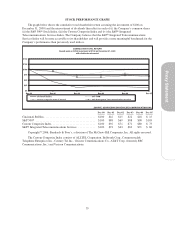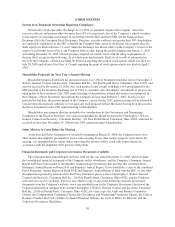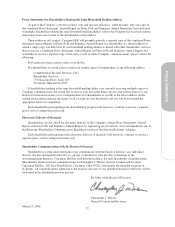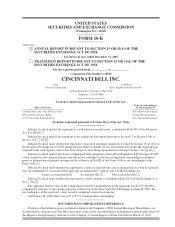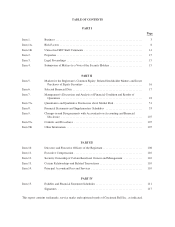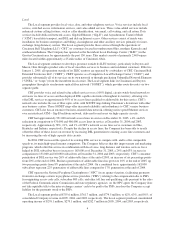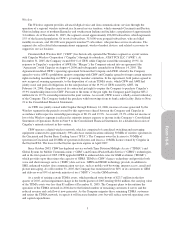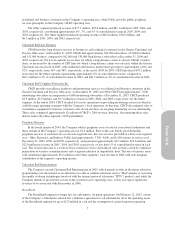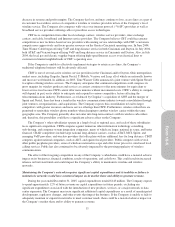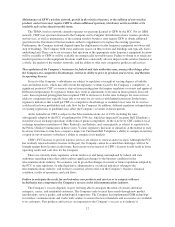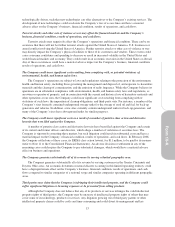Cincinnati Bell 2005 Annual Report Download - page 54
Download and view the complete annual report
Please find page 54 of the 2005 Cincinnati Bell annual report below. You can navigate through the pages in the report by either clicking on the pages listed below, or by using the keyword search tool below to find specific information within the annual report.Local
The Local segment provides local voice, data, and other telephone services. Voice services include local
service, switched access, information services, and value-added services. These value-added services include
enhanced custom calling features, such as caller identification, voicemail, call waiting, and call return. Data
services include dedicated network access, Gigabit Ethernet (“Gig-E”) and Asynchronous Transfer Mode
(“ATM”) based data transport, and DSL and dial-up Internet access. Other services consist of inside wire
installation for business enterprises and billing, clearinghouse and other ancillary services primarily for inter-
exchange (long distance) carriers. The Local segment provides these services through the operations of
Cincinnati Bell Telephone LLC (“CBT”) to customers located in southwestern Ohio, northern Kentucky and
southeastern Indiana. The Company has operated as the Incumbent Local Exchange Carrier (“ILEC”) in the
Greater Cincinnati area for approximately the past 130 years. This market consists of primarily 2,400 square
miles located within approximately a 25-mile radius of Cincinnati, Ohio.
The Local segment continues to develop a presence outside its ILEC territory, particularly in Dayton and
Mason, Ohio through a product suite of local voice/data services to business and residential customers. Effective
January 1, 2005, all operations outside of its ILEC territory are operated by a subsidiary of CBT, Cincinnati Bell
Extended Territories LLC (“CBET”). CBET operates as a Competitive Local Exchange Carrier (“CLEC”) and
provides substantially all of its services on its own network or through purchasing Unbundled Network Elements
(“UNE-L” or “loops”) from the incumbent local carrier. The Local segment links its Cincinnati and Dayton
geographies through its synchronous optical fiber network (“SONET”), which provides route diversity via two
separate paths.
CBT provides voice and related value added services over a 100% digital, circuit switch-based network to
end users via lines of access and has deployed DSL capable electronics throughout its territory, allowing it to
offer DSL services to approximately 90% of its access lines qualified or addressable for this service. CBT’s
network also includes the use of fiber-optic cable, with SONET rings linking Cincinnati’s downtown with other
area business centers. These SONET rings offer increased reliability and redundancy to CBT’s major business
customers. CBT also has an extensive business-oriented data network, offering native speed Ethernet services
over an interlaced ATM – Gig-E backbone network, delivered to end users via high-capacity circuits.
CBT had approximately 931,000 network access lines in service on December 31, 2005, a 4% and 6%
reduction in comparison to 970,000 and 986,000 access lines in service at December 31, 2004 and 2003,
respectively. Approximately 78%, 21%, and 1% of CBT’s network access lines serve customers in Ohio,
Kentucky and Indiana, respectively. Despite the decline in access lines, the Company has been able to nearly
offset the effect of these losses on revenue by increasing DSL penetration to existing access line customers and
by increasing the sale of high capacity data circuits.
In 2004, CBT increased the speed of its existing DSL service to compete with, and to offer comparable
speeds to, its main high-speed internet competitors. The Company believes that this improvement and marketing
programs, which offer this service in combination with local voice, long distance and wireless services, have
helped its DSL subscriber base to increase to 163,000 as of December 31, 2005, a 24% and 63% increase in
comparison to 131,000 and 100,000 subscribers at December 31, 2004 and 2003, respectively. CBT’s consumer
penetration of DSL service was 26% of addressable lines at the end of 2005, an increase of six percentage points
from 20% at the end of 2004. Business penetration of addressable lines has grown to 10% at the end of 2005, up
two percentage points from 8% penetration at the end of 2004. On a combined basis, approximately 163,000
subscribers represent 22% penetration of addressable lines compared to 17% penetration at the end of 2004.
CBT operates the National Payphone Clearinghouse (“NPC”) in an agency function, facilitating payments
from inter-exchange carriers to payphone service providers (“PSPs”) relating to the compensation due to PSPs
for originating access code calls, subscriber 800 calls, and other toll free and qualifying calls pursuant to the rules
of the Federal Communications Commission and state regulatory agencies. As the NPC agent, the Company does
not take equitable title to the inter-exchange carriers’ cash to be paid to the PSPs, nor does the Company accept
liability for the payments owed to the PSPs.
The Local segment produced $755.6 million, $761.7 million, and $774.5 million, or 62%, 63%, and 50%, of
consolidated Company revenue in 2005, 2004, and 2003, respectively. The Local segment produced consolidated
operating income of $276.1 million, $279.1 million, and $282.7 million in 2005, 2004, and 2003, respectively.
4





